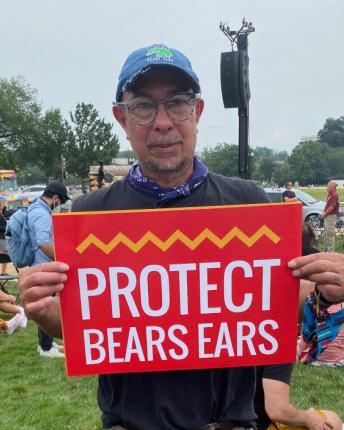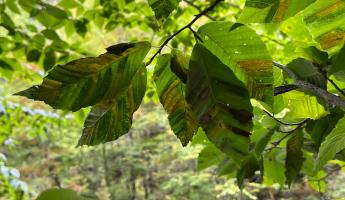
In the U.S. there are about 600 million acres of public lands and more than 100 million acres of Indigenous lands. How to balance co-management, shared stewardship, and tribal sovereignty to protect and sustain these areas is a fundamental question in conservation — and that has been the focus of Pat Gonzales-Rogers’ life’s work.
The issue of land conservation and management has been getting worldwide attention as leaders of 191 nations recently approved a U.N. agreement to protect 30% of the Earth’s land and oceans by 2030. President Biden authorized a similar measure under an Executive Order to preserve 30% of U.S. waters and public lands by 2030.

Pat Gonzales-Rogers calls attention to the need to preserve sacred tribal lands during a July 29, 2021, ceremony in Washington, D.C. Gonzales-Rogers was executive director of the Bears Ears Inter-Tribal Coalition at the time.
A former director and current consultant for the Bears Ears Coalition, Gonzales-Rogers has brought his deep experience on these issues to the Yale School of the Environment. This spring he is teaching a tribal resources and sovereignty clinic hosted by the Yale Center for Environmental Justice (YCEJ), which is open to students from YSE, Yale Law School, Yale School of Management, and Yale Divinity School. As part of his work at Yale, he will be bringing together tribal leaders, policy makers, and conservation NGOs in partnership with The Forest Dialogue to develop a white paper on best practices of co-management of lands at a conference this spring..
Gonzales-Rogers, who previously served as senior policy advisor and regional chief of congressional and legislative affairs for the Department of the Interior and assistant general counsel for the U.S. Senate Indian Affairs Committee, was recently named to the America the Beautiful steering committee, which is overseeing $91 million in grants to support landscape-scale conservation projects. At least 14 tribal nations have received grants thus far. In a recent conversation with YSE News, Gonzales-Rogers discussed the historic challenges tribal nations have faced in managing lands and how they can be overcome, as well as his advice to students planning careers in conservation.
What are the biggest challenges facing tribal nations in managing lands?
The history of tribes in the U.S. is far more complicated than we view at the surface. The foundations of how we developed Indian law and policy is derived from a Catholic doctrine called the Doctrine of Discovery, which instructs that tribes are subordinated and do not have a right to own land. It allows the ruling sovereign to basically be a fiduciary to native communities. (The doctrine is public international law giving property and sovereignty rights to European nations for lands discovered by their explorers that were not populated by Christians.) It was established by the church in the late 1400s and is still law that is cited by our Supreme Court. The worth of the lands that tribes occupy but don’t own is probably over a trillion dollars, and there are mineral and extraction rights that, if countries pivot from, would create financial fissures. All of this is what creates challenges and limitations. I tell my students that if you want to have a career working exclusively within Indian country, or you are considering working within the scope of public lands, you need to be knowledgeable about this historical context.
What are some approaches that can help to overcome these challenges?
Tribes have been the original stewards and conservators of lands, and I don’t think we give tribes enough credit for how they have managed lands. They have a proven track record, which in some instances is 20 times as long as the largest conservation groups, but they get a sliver of the assets, and they lack the opportunity to be in the room to articulate their own solutions. Too often the models for large conservation efforts have been very parochial and provincial. Tribes need to be the primary decision makers and not be in subordinated roles.
What advice do you have for students working on land management and conservation?
I am part Samoan, and my background is what I call a Polynesian precept, which is a tie to the land. “Aloha Aina” means love of land, that you and the land are one and you should operate from a management style of love, not fear. I really encourage my students to create a relationship of trust through collaboration and partnerships with communities, so they have a parity of relationships and an exchange of ideas. The approach should be: how can we help each other because your ideas are just as valuable as mine and, in some instances, you know more than I do, so I stand ready to assist you.
How can Indigenous communities contribute to the recent 30x30 land and water conservation agreements by world leaders seeking to mitigate climate change and protect biodiversity?
While Native communities are only 6% of the global population, their land contains 85% of global biodiversity. Additionally, their cultures are spiritually and inextricably linked to biodiversity and the landscape. By protecting these large landscapes, we not only ensure protection of biodiversity, but also sacred sites and places of worship. And, as we push to a greener future with renewable energy, we need to be dutiful and resist the urge to do it on the backs of Indigenous communities. It is estimated that almost 60% of the areas that contain precious metals needed to advance the transition to clean energy is within Indigenous communities. We need to ensure as we move forward that these areas are observed and protected.
What are the goals of your upcoming conference in Washington, D.C. this spring focusing on the effective tribal co-management of lands and conservation?
We are going to bring together students and thought leaders from Capitol Hill, the White House, native communities, and NGOs to identify the attributes and levers to successful co-management. It will be a working meeting to produce a very tangible document, a white paper. Tribes have been part of U.S. history from the very beginning. Their creation stories are ones that are actually scientific observations. Traditional and native knowledge has many of the answers we are looking for that we can marry in tandem with science.
Published
December 21, 2022
Media Contact



